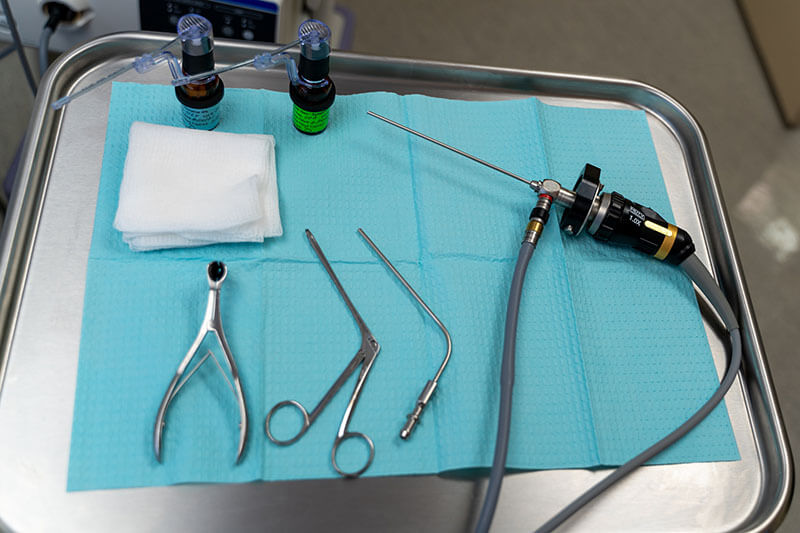
What to Expect at your Visit
- When you are contacted to schedule your initial visit, you can choose to either come in person to the office or to meet your provider over a video visit first to discuss your nose and sinus issues.
- If and when you come to the office, please bring any questionnaires or surveys that were sent to you, and all past medical records and images such as CT or MRI scans. If you can send this information before your appointment so that it can be scanned into your chart and reviewed by your provider, that is even better.
- During your visit, your provider will obtain a detailed history and perform an examination which may include a nasal endoscopy, which is a camera that is used to evaluate your nose and sinuses. Numbing spray will be used to make the camera more comfortable. It takes less than a minute to perform but can offer lots of great insight into your possible condition.
- Following this, treatment options and a treatment plan will be discussed. This may include biopsies, further imaging, medicine, office procedure, or surgery in the operating room depending on your diagnosis.
- If follow-up is needed, this will be scheduled as an office visit or a Zoom video visit depending on the reason for follow-up (for example, the need for a repeat sinus debridement will occur in person, but discussion of pathology or imaging results can take place over a video visit).

Conditions and Treatment
The inability to breathe through one’s nose has a huge impact on quality of life. There are many reasons why your nose can feel clogged. These reasons include allergic rhinitis, nonallergic rhinitis, sinusitis, nasal polyps, or anatomic findings such as a deviated septum, inferior turbinate hypertrophy, and/or nasal valve collapse.
Nasal Obstruction Treatment
Treatment depends on the cause, which will be determined by looking in your nose with a camera at your appointment. Medical management includes saline sprays or rinses, oral or intranasal steroids, oral or intranasal antihistamines, oral or intranasal decongestants, and antibiotics. Surgery is sometimes necessary if medical management fails, which could include septoplasty, turbinate reduction, or endoscopic sinus surgery based on the cause of the obstruction.
The septum is located in the middle of the nose and divides our nasal passages into a right and left side. The front part of the septum is made up of cartilage and the portion further back in the nose is comprised of bone. The cartilage and bone are lined by nasal mucosa on both sides. The nasal mucosa supplies the blood supply to the septum. If the cartilage and/or bone is deviated to one or both sides, this can cause nasal obstruction.
Deviated Septum Treatment
Treatment consists of a trial of saline sprays and intranasal steroids. If this fails to provide adequate improvement, a septoplasty can be performed in the operating room. An incision is made inside the nose and the nasal mucosa is carefully lifted off of the cartilage and bone. The deviated portions of the cartilage and bone are either removed or repositioned, and then the nasal mucosa is laid back down. Splints are sometimes placed and will be removed in clinic 1-2 weeks later. It is important to start saline sprays or rinses the night of or morning after the surgery. Risks include bleeding, pain, septal hematoma, septal perforation.
There are 3 turbinates in each nasal passage – inferior, middle, and superior. The turbinates are made up of bone that is covered by nasal mucosa. The inferior turbinate is located along the nasal floor and is the most likely to swell up in response to weather, allergens, etc. If swollen, this can result in significant nasal obstruction and nasal congestion.
Turbinate Hypertrophy Treatment
Treatment includes saline sprays or rinses, intranasal corticosteroids, intranasal antihistamines, and/or immunotherapy (allergy shots or drops) if significant allergies are present. If symptoms are refractory to medical management, an inferior turbinate reduction and outfracture can be performed. This involves removing some of the excess turbinate mucosa and pushing the bone over to create more space in the nasal passage. This can be performed in the office (if you are a candidate based on your exam and level of comfort), or it can be performed in the operating room. If you need a septoplasty and turbinate reduction at the same time, this procedure will be performed in the operating room.
Nosebleeds are very common, but can become extremely bothersome if they occur frequently. The most common reason for recurrent nosebleeds is dryness of the nasal lining from weather, allergies, sinus disorders, or sometimes the reason is unknown. Very rarely, nosebleeds can be a sign of something more serious like a mass in the nose or a hereditary condition called Hereditary Hemorrhagic Telangiectasia. The reason for your nosebleeds will be determined by examining the inside of your nose in the office.
Epistaxis Treatment
For nasal dryness, treatment consists of daily moisturizing measures – saline sprays, saline rinses, saline gel or Vaseline, humidifiers in your home. Sometimes cautery will be offered in the office setting. If your nosebleeds continue, you may benefit from a procedure in the operating room to cauterize your nose or ligate blood vessels in the nose. Embolization by our Interventional Radiology colleagues may also be an option.
The most common symptoms of sinusitis include nasal congestion, nasal drainage, facial pressure, and decreased smell. In acute sinusitis, symptoms last for 4 weeks or less and sometimes improve without treatment and sometimes require medication like antibiotics. Acute sinusitis rarely requires surgery unless there is a complication like an abscess or if the acute sinus infections become recurrent (meaning that they occur 4 or more times a year).
Acute and Chronic Sinusitis Treatment
In chronic sinusitis, symptoms are present for 12 weeks or more and are unlikely to resolve with just observation. Treatment starts with medical management and can include saline rinses, intranasal steroids, antibiotics, oral steroids, and/or allergy treatment based on your symptoms and exam findings. If medical management fails to improve your symptoms to a level that is tolerable, sinus surgery will be considered. Sinus surgery involves using a camera and instruments through your nose (no incisions on the outside of the face are necessary unless in rare circumstances) to remove polyps if presents, widen the openings of the sinuses, and clean out any mucous or fungus in the sinuses. Packing and/or splints may be placed in the nose and will be removed at your follow-up visit.
Fungus can collect in the sinuses in a few ways. One way is a disease called Allergic Fungal Sinusitis where a person’s allergy to fungus causes thick mucous and polyps to form in the sinuses. This type of fungal sinusitis occurs more frequently in people who live in warm and humid climates. Another type of sinus fungus is called a fungal ball, which is a large collection of fungal elements in (usually) just one sinus - most commonly the maxillary sinus or sphenoid sinus. Both of these disease processes occur in people with normal immune systems and are not life-threatening. A life-threatening form of fungal sinusitis is called Acute (or sometimes Chronic) Invasive Fungal Sinusitis. This type of fungal sinusitis only occurs in people with poor immune systems (chemotherapy, uncontrolled diabetes, etc) and is a true emergency. Patients with this form of fungal sinusitis are very sick and will likely present to the hospital and not the office setting.
Treatment Fungal Sinusitis Treatment
Treatment for both Allergic Fungal Sinusitis and fungal ball is surgery to remove the fungal elements. An oral prednisone taper is also recommended after surgery for Allergic Fungal Sinusitis, and salt water rinses are recommended after surgery for both (as is usual for the post-operative period after any type of nose or sinus surgery). Treatment for the invasive form of fungal sinusitis is to attempt to improve the immune system, surgery to remove the infected tissue, and antifungal medications.
Chronic sinusitis is divided into chronic sinusitis with nasal polyps and chronic sinusitis without nasal polyps. Nasal polyps are painless and benign tissue growths in the nasal passages thought to be caused by chronic inflammation. In chronic sinusitis with nasal polyps, the symptoms are the same as the ones listed above - nasal congestion, nasal drainage, facial pressure, and decreased smell.
Nasal Polyps Treatment
Treatment consists of medical management first which includes oral prednisone, salt water rinses, and intranasal corticosteroids. If this fails, or if prednisone courses are needed very frequently to keep the symptoms under control, sinus surgery can be offered.
There are different types of non-cancerous tumors that can grow in the nose and sinuses and cause bothersome symptoms such as nasal obstruction, facial pressure, epistaxis, and nasal drainage. Examples of these are vascular tumors (such as pyogenic granuloma), bone tumors (such as osteoma), and soft tissue tumors (such as inverted papilloma).
Benign Sinus Tumors Treatment
These tumors do not respond to medication, so need to be removed surgically. In the vast majority of cases, these benign tumors can be removed through the nose using a camera and sinus instruments so that no cuts are made on the outside of the face. It should be noted that although inverted papilloma is a benign tumor, it does have the potential to transform into cancer, so surgical removal is always recommended even if it is not causing bothersome symptoms.
Sense of smell is extremely important in everyday life. For starters, it helps us enjoy life since it is involved in forming memories, in social interactions, and in many occupations. It is also important for safety, as we need to be able to smell spoiled foods, smoke/fire, gas leaks, and polluted air.
Loss of smell occurs in 2 major ways: either smell particles are blocked from entering the nose or the smell nerves themselves are not working. The first way is called conductive smell loss and can occur if the nasal passages are swollen/inflamed from a upper respiratory infection or sinusitis. This type of loss can also be caused by nasal polyps or tumors in the nose. The other type of smell loss is called sensorineural loss and has many different potential causes such as long-term nerve damage after an upper respiratory infection, head trauma, normal aging, certain medications, toxins such as cigarette smoke, neurodegenerative disorders (Parkinson’s, Alzheimer’s), and malnutrition.
Smell Disorders Treatment
Treatment depends on the cause of the smell loss. If it is a conductive loss, medications or surgery can be used to improve the blockage in the nasal passages and therefore hopefully improve smell. For sensorineural loss, there is unfortunately no treatment options that are 100% effective, but one treatment that has shown promise in patients with sensorineural smell loss is called Olfactory Training. This involves smelling 4 different essential oils scents for 15 seconds each twice a day. A more detailed explanation of this treatment option as well as where to purchase a Smell Kit can be found in the Patient Education section. The hope is that this treatment will rewire the neural connections in the brain, almost like physical therapy for your smell.
Cerebrospinal fluid (CSF) is a clear body fluid that surrounds the brain and spinal cord, and functions to cushion the brain within the skull and circulate nutrients and waste products to and from the brain. The sinuses sit near or under the brain, and are separated from the brain and CSF by a layer of bone and the dura, which is the outermost membrane that covers the brain and spinal cord. If a defect occurs in the dura and bone between the brain and sinuses, CSF can leak into the nose.
This can happen due to severe trauma, and this type of CSF leak will oftentimes resolve without intervention as the swelling in the area of injury heals. However, some CSF leaks occur spontaneously, usually due to increased intracranial pressure that over time causes a breakdown and subsequent connection between the brain and sinuses.
Cerebrospinal Fluid Leaks Treatment
This type of CSF leak requires surgical repair to stop the leak and because of the risk of meningitis if the connection is not closed. Surgery again takes place through the nose using a camera and sinus instruments, and the hole is closed with a combination of bone, nasal tissue, and synthetic packing materials. Sometimes a lumbar drain will be placed before the surgery and removed prior to discharge. After surgery, it is important not to strain or perform any activities that will increase pressure in the head for a few weeks.
Encephaloceles are similar to CSF leaks, meaning there is a connection between the brain and sinuses and fluid leaking out of the nose, but this type of connection includes a piece of the brain protruding into the nasal passage or sinus.
Encephaloceles Treatment
As with CSF leaks, treatment is surgery through the nose to remove the piece of brain (this piece of brain is always non-functioning so there is no neurologic consequence to removing it) and repair the defect between the rest of the brain and the sinuses.
Grave’s disease is an autoimmune condition that causes the thyroid to make too much thyroid hormone (hyperthyroidism). In this disease, the immune system can also attack the muscles and soft tissue in the eyes to give patients a “bulging eye” appearance.
Grave’s Eye Disease Treatment
In severe cases where vision may be affected, surgery can be performed through the nose to remove some of the bone around the eye to improve the appearance of the eyes and hopefully improve the changes in vision as well.
A blocked tear duct can cause chronic eye tearing that can be very bothersome.
Tear Duct Obstruction Treatment
If conservative treatment options don’t work, surgery to open up the tear duct can be performed externally through an incision near the eye, or endoscopically through the nose. In the latter approach, we work with our Oculoplastic colleagues to drill away the bone around the tear duct, cut open the duct so it can freely drain, and place a stent in the duct for the next weeks while the tear duct heals. The stent is then removed through the nose in the office.

